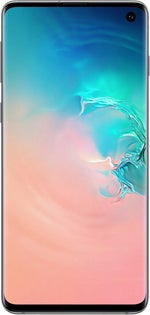Galaxy S10+ vs LG G8 and V50, first look at Android's best flagships of the season
When it comes to Android flagships, there is no better rivalry than the one between the two Korean juggernauts - Samsung vs LG - at least in the US where Chinese phone makers will be stigmatized for the foreseeable future. Hence our Galaxy S10+ vs LG G8 ThinQ comparison and the 5G-laden LG V50 is waiting in the wings for a good measure, too.
Galaxy S10+ vs LG G8/V50 design and displays
Samsung made the hole-in-display design mainstream with the S10 family, but LG has a unique ace up its G8 sleeve, too, and it is the display-as-a-speaker feature. Borrowed from LG's Crystal Sound OLED displays that can be found on some of the company's high-end TVs, the display of the G8 vibrates to emit noise. Samsung has a similar technology called Sound-on-Display in the pipeline but the S10 series isn't landing it yet.
As you can see, the G8 is chinnier than the S10+ but lacks the unsightly elliptical cutout of Samsung's Infinity-O design that houses the dual front cameras, replacing it with a good old-fashioned unsightly notch instead. Both approaches are ho-hum solutions to the "all-screen" conundrum but not a deal breaker as we got quickly used to these screen interruptions while perusing the handsets. The V50 kept a conservative design approach that resembles the V40 very much. Why break a good thing when you can focus on the 5G connectivity it offers instead?
Other than the holes and protrusions, the S10+ and G8 feel as premium as they can be clad in glass derivatives and feeling reassuringly solid in the hand. Despite the beautiful curved sides of the flexible AMOLED display on the S10+, we found the G8 to be the more elegant of the two thanks to its more compact frame and camera area that is flushed with the rear surface. The 6.1" panel of the G8 and the 6.4" screens of the S10+ and the V50 looked bright and superbly colored when looked on directly with a very slight blueish or greenish tint from an angle as OLEDs are known to perform.
Galaxy S10+ vs LG G8/V50 hardware and cameras
What can we say, you can't do much better than the latest 7nm chipsets, and that's exactly what the G8 and S10+ carry so they felt extremely fast and fluid with enough RAM to hold tens of apps on the backburner. The nudge here is toward Samsung's new One UI interface that makes the phone look and feel rather fresh and quick.
At first blush, Samsung offers a more diverse camera portfolio on the S10+, adding a telephoto zoom lens to the variable aperture main camera and the wide-angle one. The G8 also has a wide-angle second rear cam but the V50 one-ups it with a telephoto piece for a complete combo just like on Samsung's phone. Flip the phones around, though, and the G8 offers a time-of-flight front sensor to counter the dual selfie camera of the S10+ for better portrait shots.
Unique propositions
The so-called "Z" front camera of the G8 allows more precise 3D face-unlocking, hand gesture navigation, and even vein pattern recognition which makes for no less than three biometric solutions on one phone. We like the concept but air gestures are still a bit of a niche undertaking though waving over your phone to stop the alarm from ringing in the morning beats opening your eyes and fumbling for a tiny snooze button.
LG keeps piling on, though, pairing the "Boombox" lower speaker with a whole Crystal Sound one that consists of the full 6.1" display. That's not the piezoelectric speaker of phones from Xiaomi or Vivo that came to replace the earpiece. The Crystal Sound OLED has an exciter underneath and the whole display canvas can serve as an amplifier. Not only that, but the top half can serve as a second loudspeaker for a strong and excellent stereo surround sound though we didn't get to thoroughly test LG's claims as there was so much noise on the show floor, audio tests were near useless.
Samsung, in its turn, may offer only one biometric approach for unlocking and securing the S10+ but its in-display finger scanner is the first of its kind that leverages the second generation of ultrasonic under-glass readers for fast and precise reaction. LG's palm-reading is undoubtedly cool but that's about the only factor going for it, as it is less practical than simply tapping quickly in the middle of the S10+ screen to unlock or authorize a purchase. As for the V50, well, having 5G connectivity is a miracle in its own right, yet the S10 family also has one such member that is coming later this year.
The Nutshell
Both Samsung and LG have done a commendable job to offer worthy upgrades for those who come from an S8 or a G6 and V40. Are these phones worth their hefty price tags for upgraders from more recent flagship phones of these companies? From the G7, sure, but LG has still to announce the exact tags of the G8 and V50 in the US.
The sheer new design of the S10+, on the other hand, and the commendable battery size coupled with the fastest processor and excellent camera set would make for an affirmative answer even in that case.
Follow us on Google News




















Things that are NOT allowed:
To help keep our community safe and free from spam, we apply temporary limits to newly created accounts: